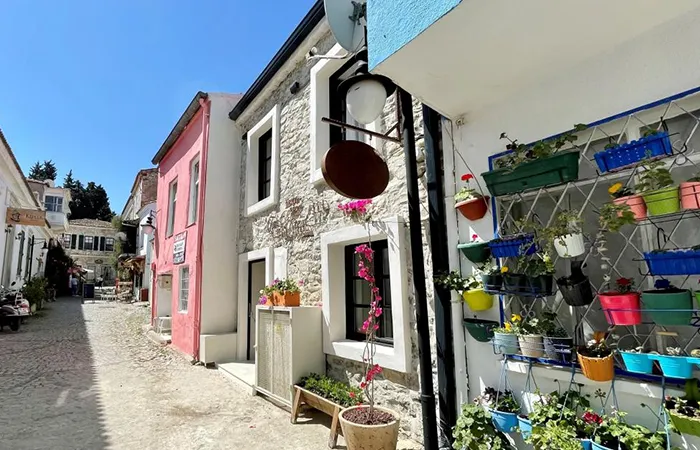Liman Tepe, one of the most important settlements of the western Anatolian coastal region, has a unique character in terms of its uninterrupted settlement history from the Chalcolithic Age to the end of the Roman Period. As a result of 28 years of archaeological excavations at Liman Tepe, 7 architectural layers dating from the Middle Chalcolithic Period to the Late Roman Period have been identified. With these data, a very important chronological index has been created for both the settlement and the Aegean world. Within this chronological sequence, the earliest architectural layer of the settlement is dated to the beginning of the 5th millennium BC, the Middle Chalcolithic Period. In the light of the finds, it is understood that the city was a strong port city at the centre of overseas trade relations from the earliest cultural layers. This centre, which gained a different dimension with the introduction of urbanism in the Early Bronze Age, was renamed Klazomenai in the Classical Period.
With the Migration of the Aegean Sea Tribes that started around 1200 BC, the site states became civilisation centres. By the 8th century BC, Klazomenai completed its political formation, took its place in the history of civilisation and joined the city-state system. In the meantime, it was subjected to various invasions and uprisings since the 6th century BC. For this reason, the people left the city on the mainland and settled on the island known today as Karantina Island on the opposite coast. It is understood that the city on the island was abandoned in the 5th century AD. It is possible that the city, which is mentioned in the Council of Chalkedon in 451 AD, the lists of Hierocles in 530 AD and some later episcopal lists, was located in Gülbahçe Village, where a church ruin and Byzantine inscriptions were found.






The Turks reached the Aegean Sea and Izmir in 1080s by Çaka Bey. Çaka Bey, who established the first navy of the Turks, captured coastal cities. Among these cities was Klazomenai. The principality founded by Çaka Bey disintegrated with his death. After this date, there was a Turkish-Byzantine struggle in Western Anatolia for two centuries.
With the collapse of the Anatolian Seljuk State in 1308, the period of principalities began in Anatolia. İzmir and Urla were annexed to the lands of Aydınoğlu Principality in 1329 by Aydınoğlu Gazi Umur Bey and İbrahim Bahadır Bey. In 1390, Aydın and its surroundings, which were taken over by the Ottomans in 1390, were again taken over by the principality after Yıldırım Bayezid lost the Battle of Ankara, and Urla was completely taken over by the Ottoman Empire after Murat II abolished the principality in 1425-1426.
During the Ottoman Empire, Urla became a port city of great importance in domestic and foreign trade. After 1520, Suleiman the Magnificent gave some villages of Urla to his mother Hafsa Sultan, who endowed these villages to the complex she built in Manisa. Kilizman and the areas in the centre, which were outside these villages, were added to the sultan’s endowment. Maritime trade in Urla began to decline in the late 16th century. The most important reason why merchant ships no longer called at this harbour was, as the great Turkish mariner Piri Reis said, that these waters were a hotbed of pirates.
Izmir was occupied by the Greeks on 15 May 1919, citing the articles of the Treaty of Sevres signed as a result of World War I. On the morning of 15 May 1919, the first resistance in Western Anatolia against the Greek occupation started in Urla on the morning of 16 May. When 800 local Greeks learnt about the occupation of Izmir, they attacked the Turks. At this time, the 173rd Regiment of the 56th Division was stationed in Urla. The Regiment Commander, with a small number of soldiers and the Turkish people who came to their aid, resisted these attacks with a force of approximately 120 people.
The clashes between the regiment and the Greek gangs continued throughout the days of 16 and 17 May, and the firing ceased on the evening of 17 May. With this event, the first Kuvayı Milliye struggle started in Western Anatolia, and this armed resistance of the Turkish soldiers and people was accepted as the ‘first clash’ with the Greeks in the West, although it was not against Greek soldiers but against Greek gangs. As a result of the clashes, Urla remained under occupation for 3 years, 3 months, 3 weeks and 3 days as of 18 May until 12 September 1922, the day of liberation.
In the Battle of the Commander-in-Chief, which started on Saturday 26 August 1922 and was victorious in Dumlupınar on 30 August 1922, the Greek army, which suffered a decisive defeat, began to retreat, and Mustafa Kemal Pasha gave his famous order to prevent the retreating army from forming a new line of defence; ‘Armies, your first target is the Mediterranean. Forward!’. The pursuit, which started with this order, reached its conclusion with the entry of the Turkish army into Izmir on 9 September. On 10 September, Mustafa Kemal Pasha and İsmet Pasha arrived in İzmir together with the accompanying commanders. When it was learnt that the remaining forces of the Greek army were preparing to flee to Çeşme and leave Anatolia by ships from there, Fahrettin (Altay) Pasha, the Commander of the 5th Cavalry Corps, was assigned to uproot the enemy from the Peninsula. Thus, the Urla Peninsula Pursuit Operation, one of the last phases of our War of Independence, began. Urla was liberated from the enemy on 12 September 1922.

Dia Urla is located in the center of Urla, 30 km from Izmir center and approximately 45 km from Izmir Adnan Menderes Airport; It is a family business. Our establishment, where you will feel the warm atmosphere with its stylish and elegant rooms carefully designed in line with the needs of its guests with 25 years of knowledge, experience and knowledge coming from the tourism and service sector, is a unique choice for accommodation in Urla.
